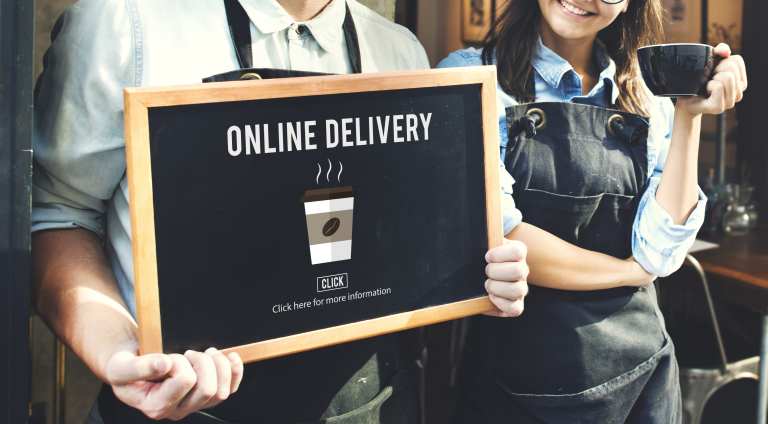New Formats Deliver For Food Ordering

For quick-service restaurants (QSRs), tried and true practices might not be cutting it anymore. Drive-thrus, practically invented by QSRs, are having trouble living up to the fast promise of fast food. This year, consumers spent an average of 20 seconds longer waiting in the drive-thru lane than they did last year.
Out of necessity, restaurants are turning to a wide range of new technologies to deliver on changing ordering preferences. The new Order To Eat Tracker highlights how solutions from facial recognition, voice and virtual-only models are becoming increasingly common on the restaurant landscape.
Changing Consumer Behavior
These new models are attempting to adapt to changes in consumer behavior. For instance, just 15 percent of restaurant sales now come from in-restaurant diners. At the same time, online food delivery increased nearly 15 percent between 2018 and 2019.
A new study also found that 34 percent of consumers used delivery more than they did a year ago. Specifically, 79 percent used restaurant delivery at least once a month, with roughly 53 percent of those via third-party apps.
It’s no wonder more than three-fourths (78 percent) of operators considered off-premises programs strategic priorities.
Drive-Thrus are Getting Digital Makeovers
While drive-thrus can be a source of retail innovation, traditional operations aren’t what they used to be. According to a new study, customers spent an average of 255 seconds from speaker to order window in 2019, about 20 seconds longer than in 2018.
The study also found Dunkin’ had the fastest drive-thrus, with an average of 217 seconds, which is likely due to Dunkin’s simpler orders compared to other brands. This was reinforced by the fact that breakfast was the daypart with the fastest drive-thru service at 239 seconds.
Digital menus, which were a major factor for McDonald’s in its Dynamic Yield acquisition, can do upselling for an employee by suggesting potential add-ons on the screen. That said, digital menus are still relatively rare. Only 19.3 percent of all visits in the study included a digital menuboard. No surprise, McDonald’s had the highest adoption rate at 60.6 percent, followed by Carl’s Jr. (22.0 percent).
An offshoot of digital menus, order-confirmation boards (OCB) have wide-ranging adoption rates, with 84.8 percent of Taco Bell locations featuring the technology, while only 7.3 percent of Dunkin’ restaurants do.
Biometric Kiosks Speed Orders
Self-service kiosks have been gaining popularity and cutting-edge technology like biometrics is beginning to be integrated. According to a new study from the National Restaurant Association and Technomic, 22 percent of consumers used kiosk ordering last year.
Examples include Caliburger, which has been utilizing facial recognition ordering technology in two locations, and Dallas-based Malibu Poke has also rolled out similar tech. Jon Alexis, owner of Malibu Poke, said the biometric system has effectively retained customers and helped them quickly reorder their favorite meals.
Users who approach the self-service kiosks can place a new order or a repeat order either by facial scan or by personally identifiable information (PII) like a phone number or credit card. Users ordering with the kiosk for the first time are prompted to receive a facial scan to remember the order for a future purchase.
Pickup or To Go Only
There has also been a rise in restaurants with exclusive pickup windows or lanes. Last week, Starbucks announced the opening a Starbucks Pickup store in New York City that taps into Starbucks Mobile Order & Pay.
Chipotle continues to roll out new “Chipotlanes” to a few dozen locations and plans to ramp up the pilot program later in the year. These lanes allow customers to order and pre-pay online and pickup at a designated time.
Similarly, Pizza Hut is piloting cubbies for pickup orders in California and plans to expand the test into additional West Coast cities next year. Caribou Coffee is rolling out a small-format concept in Minnesota called Caribou Cabins. These 600-square-foot stores don’t have any dine-in seating, but offer outdoor seating, a drive-thru and a walk-up window.
While McDonald’s is in the midst of a major renovation across its U.S. system that will add self-order kiosks, it is also testing a McDonald’s To Go format in London. Customers order using kiosks, staff is mainly back of house and there is no seating. The concept is meant to accommodate only diners on the go.
However, these aren’t conveniences targeted only at customers; they are also designed for ease in facilitating pick-ups through third-party delivery services.
Virtual Restaurants Appear
Virtual restaurants a.k.a. ghost restaurants, essentially kitchens for delivery orders, have become increasingly popular. With no seating for customers and smaller staffs, they are less expensive to operate than full-service restaurants
Uber has launched approximately 1,500 virtual restaurants across the U.S. and Canada, allying itself with other brands and services. The establishments are an experiment to see if partnered services can entice more consumers as they turn to online ordering.
Grubhub also recently launched a virtual restaurant concept with Just Salad, a fast-casual restaurant chain that specializes in healthier food selections.
Voice Ordering Gains Traction
One of the most visible artificial intelligence (AI) integration used by QSRs are voice-recognition systems, which have been deployed restaurants like Starbucks, Dunkin’ and Domino’s. Chipotle also recently implemented AI-based voice-activated food ordering, which it plans to introduce to all 2,500 of its locations by the end of 2019.
In September, McDonald’s acquired voice technology solutions provider Apprente. The acquisition aims to help McDonald’s improve order-taking operations in its drive-thru facilities by implementing voice-recognition technology to help customers navigate increasingly complex quick-service restaurant (QSR) menus.
According to the Technomic study, 11 percent of consumers have used voice assistant ordering. Though not a huge number, voice ordering holds promise. Nearly half (44 percent) of restaurant operators who offered voice ordering said it had a large positive impact on their business.